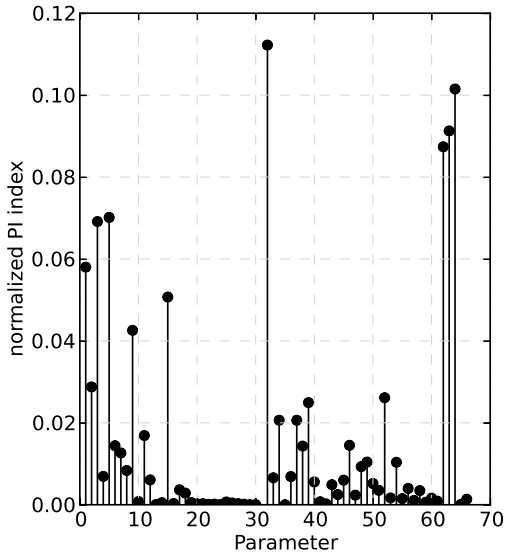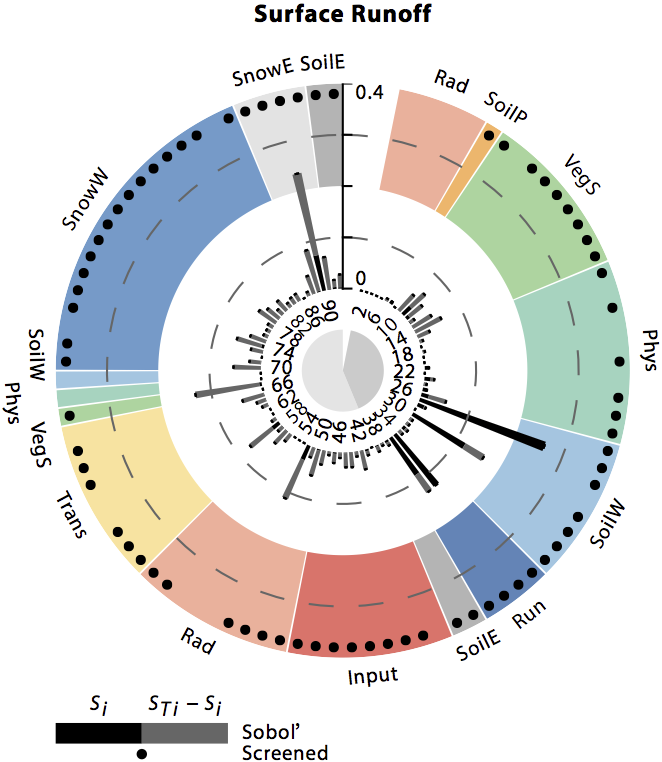Analysis of land surface models
Community Land Model CLM v3.5
Land surface models require a large number of parameters. These parameters are hard-coded as constants in the models despite they are obtained e.g. via regression methods from field data and have therefore an uncertainty range.
In this projcet we study the effect of parametric sensitivity of the model
 The CLM, rev. 3.5 parameter importance index PI for 66 model parameters, where 1-36 are soil or atmosphere related parameters, the rest are vegetation related parameters. Parameter 32 is the soil evaporation resistance parameter, 62-64 are specific leaf area, nitrogen limitation and slope of stomatal conductance respectively.
output. We apply a global sensitivity design using stratified random sampled parameter values and conducting local derivative based parameter pertubations. The relative sensitivity of three model outputs, latent and sensible heat as well as photosynthesis, is captured via an objective function of normalized squared flux deviations. For determine sensitive model parameters and their mean relative effect on the model outputs, we apply an eigendecomposition on a matrix containing numerical information of the objective function. After introducing a parameter importance index, see Figure, we propose a new criterion acting on this index, to determine the important model parameters depenent on a user specific confidence level for e.g. parameter estimation purposes.
The CLM, rev. 3.5 parameter importance index PI for 66 model parameters, where 1-36 are soil or atmosphere related parameters, the rest are vegetation related parameters. Parameter 32 is the soil evaporation resistance parameter, 62-64 are specific leaf area, nitrogen limitation and slope of stomatal conductance respectively.
output. We apply a global sensitivity design using stratified random sampled parameter values and conducting local derivative based parameter pertubations. The relative sensitivity of three model outputs, latent and sensible heat as well as photosynthesis, is captured via an objective function of normalized squared flux deviations. For determine sensitive model parameters and their mean relative effect on the model outputs, we apply an eigendecomposition on a matrix containing numerical information of the objective function. After introducing a parameter importance index, see Figure, we propose a new criterion acting on this index, to determine the important model parameters depenent on a user specific confidence level for e.g. parameter estimation purposes.
We use the Community Land Model (CLM, rev3.5) from the National Center of Atmospheric Research, Boulder, CO (
http://www.cgd.ucar.edu/tss/clm/
).
Contact:
maren.goehler@ufz.de
matthias.cuntz@ufz.de
juliane.mai@ufz.de
Land Surface Model Noah-MP
Land surface models incorporate a large number of process descriptions with a plentitude of parameters. Some of these parameters are xed numbers in the computer code, which hinders model agility during calibration. We identied 139 hard-coded parameters in the model code of the land surface model Noah with multiple process options (Noah-MP). We performed a Sobol’ global sensitivity analysis
 Stacked bar charts of mean rst-order and total-order Sobol’ indexes Si and STi of standard and hidden parameters of the output flux surface runoff at the catchment South Branch Potomac. The lower gray bars of the stacks are Si and total stacks are STi. Sobol’ indexes are plain averages. Only parameters with a filled circle on top of the radius have Sobol’ indexes; all other parameters have a thin horizontal line on the azimuth for visual identification. Colored sections are categories of model parameters. Gray slices in the centre indicate standard (dark gray) and hidden (light gray) parameters.
of Noah-MP for a specic set of process options which includes 42 out of the 71 standard parameters and 75 of the 139 hard-coded parameters. The sensitivities of the hydrologic output uxes latent heat and total runoff as well as their component fluxes were evaluated at twelve catchments within the United States with very different local hydro-meteorologies.
Stacked bar charts of mean rst-order and total-order Sobol’ indexes Si and STi of standard and hidden parameters of the output flux surface runoff at the catchment South Branch Potomac. The lower gray bars of the stacks are Si and total stacks are STi. Sobol’ indexes are plain averages. Only parameters with a filled circle on top of the radius have Sobol’ indexes; all other parameters have a thin horizontal line on the azimuth for visual identification. Colored sections are categories of model parameters. Gray slices in the centre indicate standard (dark gray) and hidden (light gray) parameters.
of Noah-MP for a specic set of process options which includes 42 out of the 71 standard parameters and 75 of the 139 hard-coded parameters. The sensitivities of the hydrologic output uxes latent heat and total runoff as well as their component fluxes were evaluated at twelve catchments within the United States with very different local hydro-meteorologies.
Noah-MP’s hydrologic output fluxes are sensitive to two thirds of its standard parameters. The most sensitive parameter is, however, a hard-coded value in the formulation of soil surface resistance for evaporation, which proved to be oversensitive in other land surface models as well. Surface runoff is sensitive to almost all hard-coded parameters of the snow processes and the meteorological inputs. These parameter sensitivities diminish in total runoff. Assessing these parameters in model calibration would require detailed snow observations or the calculation of hydrologic signatures of the runoff data. Latent heat and total runoff exhibit very similar sensitivities because of their tight coupling via the water balance. A calibration of Noah-MP against either of these fluxes should therefore give comparable results. Moreover, these fluxes are sensitive to both, plant and soil parameters. Calibrating only soil parameters, for example, thus limits the model’s agility.
Overall it is recommended to include the most sensitive hard-coded model parameters when calibrating Noah-MP.
Contact: juliane.mai@ufz.de matthias.cuntz@ufz.de stephan.thober@ufz.de
